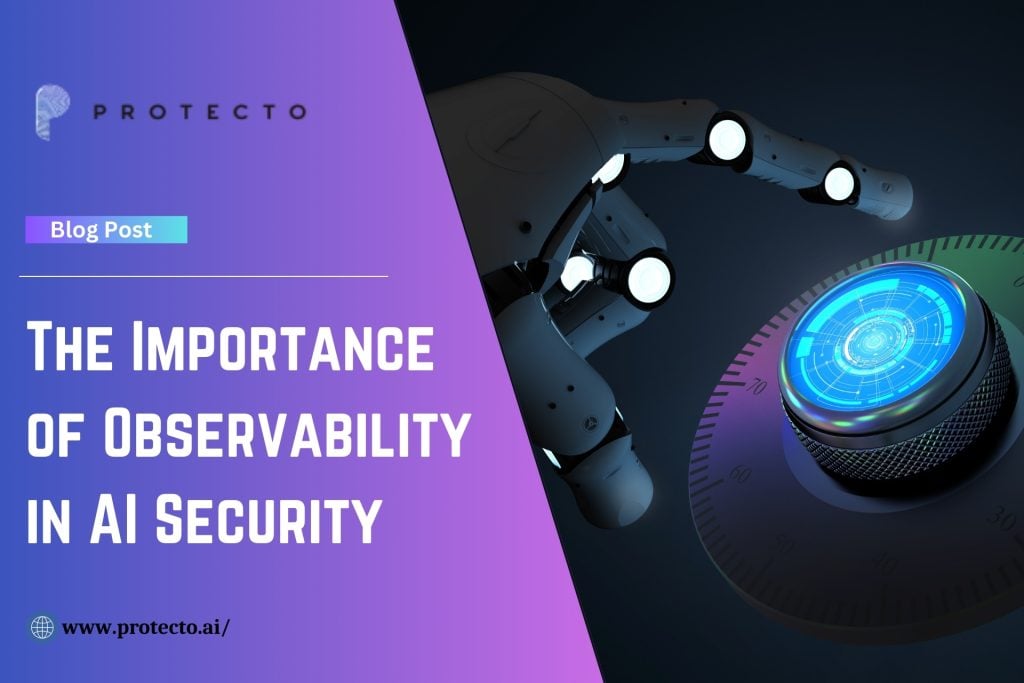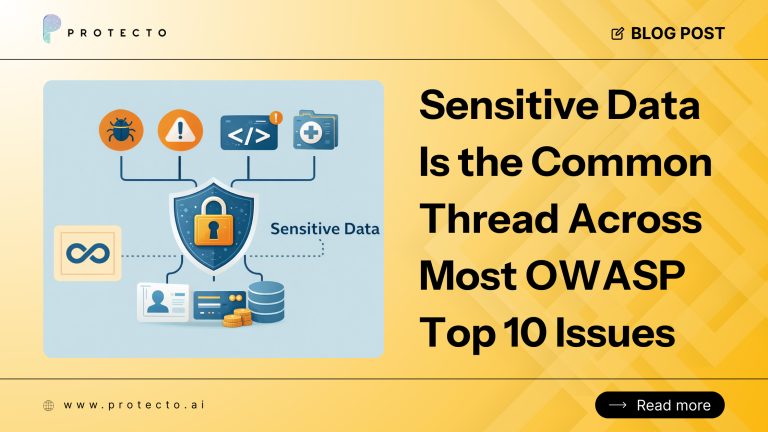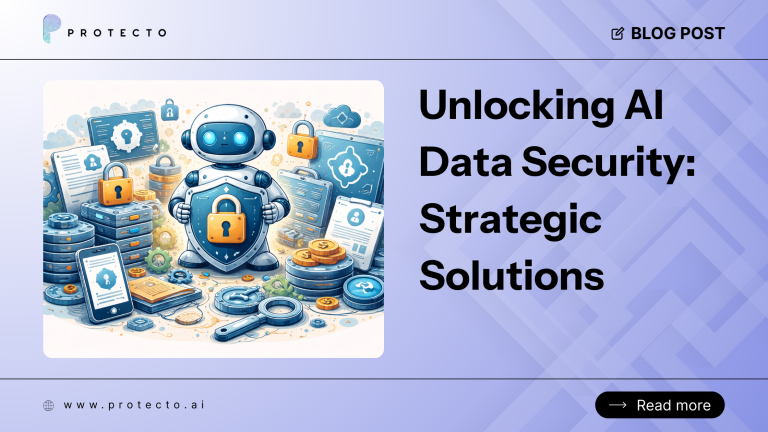The landscape of AI security is evolving at an unprecedented pace, mirroring the rapid advancements in artificial intelligence. As organizations increasingly rely on AI to drive innovation, observability’s crucial role in ensuring these systems’ security cannot be overstated.
In this dynamic evolution of AI security, it is crucial to underline observability’s pivotal role in safeguarding against emerging threats. With a keen focus on the significance of observability, this article navigates the complex terrain of AI security, offering insights into its key components, challenges, and practical implementations.
Understanding Observability in AI
Observability in artificial intelligence is a multifaceted concept encompassing various components that collectively contribute to a holistic security posture.
Observability involves the comprehensive understanding of an AI system’s internal state by examining its outputs and, crucially, the inputs leading to those outputs. There are several fundamental components of observability, encompassing aspects such as data collection, log aggregation, distributed tracing, and real-time monitoring.
Observability, however, is different from monitoring. While monitoring provides insights into the current state of an AI system, observability transcends this by offering a more profound understanding of why certain conditions occur. This distinction is pivotal, as it empowers organizations to proactively identify and mitigate potential security loopholes before they escalate.
Observability is a technical necessity and a strategic imperative in AI security. Observability is paramount in identifying anomalous behavior, understanding system intricacies, and fortifying defenses against evolving cyber threats.
The Complexity of AI Systems
The intricacy embedded within AI systems amplifies the need for robust observability.
The Interconnected Nature of AI Components
AI systems are composed of interconnected elements, each influencing the other. This complexity requires observability to decipher the relationships between components, ensuring a comprehensive view of the entire system.
Scale and Diversity of Data in AI Operations
AI operations handle vast and diverse datasets. Observability becomes essential in navigating this complexity, allowing organizations to monitor data flow, identify patterns, and promptly detect deviations from expected behaviors.
The Dynamic Behavior of Machine Learning Models
Machine learning models exhibit dynamic behavior influenced by evolving data patterns. Observability becomes a linchpin, providing real-time insights into model performance, facilitating quick adaptations to changing conditions, and fortifying against potential security vulnerabilities.
The Role of Observability in AI Security
Observability serves as a cornerstone in fortifying the security posture of AI systems, playing a multifaceted role beyond mere surveillance.
Real-time Monitoring of AI Systems
Observability enables real-time monitoring, a critical aspect in promptly identifying anomalies and potential security incidents. By continuously tracking system metrics, organizations gain instantaneous insights into deviations from normal behavior, allowing for swift response and mitigation.
Tracing and Debugging in AI Operations
Understanding the intricate flow of data and model execution is imperative for maintaining a secure AI environment. Observability facilitates tracing and debugging, providing a transparent view of how information traverses the system. Rapid diagnosis of security issues becomes feasible, reducing the dwell time of potential threats.
Logging and Auditing for Accountability
Comprehensive logging and auditing, integral components of observability, establish accountability in AI operations. By capturing relevant events and activities, organizations can adhere to compliance requirements and conduct forensic analysis in the aftermath of security incidents. This level of accountability is pivotal in understanding the root causes of breaches and implementing preventive measures.
In essence, observability acts as a proactive sentinel, standing guard over AI systems and empowering organizations to maintain a vigilant watch on their intricate operations. The ability to promptly detect, trace, and address security incidents is fundamentally linked to the robustness of observability measures, making it an indispensable ally in the ongoing battle against a long list of ever-evolving cyber threats in the AI landscape.
Critical Components of Observability in AI Security
Implementing observability in AI security requires a nuanced understanding of its key components, each playing a distinct yet interrelated role in fortifying the overall security posture.
Logging and Log Management
Comprehensive logging serves as the bedrock of observability. This involves recording relevant events, activities, and system states. In AI security, logging is not only about capturing errors but also about recording normal operations. Log management systems facilitate the aggregation, storage, and analysis of these logs, offering valuable insights into system behavior. By meticulously analyzing logs, security teams can identify patterns, anomalies, and potential security threats, forming the first line of defense in observability.
Distributed Tracing
Understanding how data flows between various components is crucial in the complex architecture of AI systems. Distributed tracing involves tracking the journey of a request or data point as it traverses through different services and components. This allows organizations to map dependencies, identify performance bottlenecks, and detect anomalies that might signify security issues. As AI systems often rely on multiple interconnected services, distributed tracing becomes vital for maintaining visibility and ensuring security across the entire system.
Metrics and Monitoring
Metrics provide quantifiable data about the performance and health of AI systems. Monitoring, on the other hand, involves continuously observing these metrics to detect deviations from normal behavior. Setting up key performance indicators (KPIs) and making use of monitoring systems enable organizations to establish a baseline for normal system behavior. Any deviation from these metrics can indicate security threats or performance issues. This real-time awareness empowers security teams to respond swiftly, minimizing the potential impact of security incidents.
In AI security, these components of observability work in tandem to create a robust and proactive defense mechanism. By synergizing logging, distributed tracing, and metrics, organizations can significantly improve their power to detect, respond to, and alleviate potential security risks, thereby elevating the overall security resilience of AI systems.
Implementing Observability in AI Security
Implementing observability in AI security requires a strategic approach, encompassing selecting suitable tools and fostering a culture that values proactive monitoring and reporting.
Selecting Suitable Observability Tools
The effectiveness of observability hinges on the judicious choice of tools tailored to the specific architecture and requirements of AI systems. Popular observability tools like Prometheus, Grafana, and ELK Stack offer functionalities like logging, metrics, and tracing. Customization of these tools to align with the intricacies of AI architectures is essential. Organizations must evaluate the scalability, compatibility, and ease of integration of these tools to ensure a seamless observability framework.
Building a Culture of Observability
Beyond tools, instilling a culture of observability is pivotal. This involves training teams on best practices related to observability, fostering a mindset that values proactive monitoring, and encouraging prompt reporting of anomalies. Units should be well-versed in interpreting observability data and translating it into actionable insights. By integrating observability into the organizational DNA, security measures become proactive rather than reactive, leading to a more resilient AI security posture.
Implementing observability in AI security is more than just a one-size-fits-all endeavor. It requires a nuanced understanding of the unique aspects of AI architectures and the dynamic nature of security threats. Through a strategic combination of appropriate tools and a culture that prioritizes observability, organizations can fortify their AI systems against emerging security challenges, ensuring robust defense mechanisms that adapt to the evolving threat landscape.
Challenges in Implementing Observability in AI Security
While the benefits of observability in AI security are substantial, implementing it comes with challenges. Addressing these hurdles is crucial to realizing the full potential of observability in safeguarding AI systems.
Overcoming Data Volume and Velocity
AI systems generate massive amounts of data, and observability compounds this volume. Dealing with the sheer magnitude of data requires scalable solutions to handle the velocity at which information is produced. Real-time analysis becomes a significant challenge, necessitating robust infrastructure and algorithms capable of promptly processing and extracting meaningful insights from vast datasets.
Addressing the Complexity of AI System Architecture
The intricate architecture of AI systems, often composed of multiple interconnected components, introduces complexity into observability. Mapping dependencies among these components and understanding the interactions pose challenges. Integration issues with observability tools in such diverse architectures further complicate matters. Overcoming these challenges hinges on a comprehensive understanding of the system’s structure and leveraging observability tools to navigate intricate AI landscapes.
Implementing observability in AI security demands overcoming these challenges to ensure a seamless and effective monitoring system. Solutions involve employing advanced analytics and machine learning algorithms to manage data volume, optimizing tools for intricate architectures, and fostering a culture of adaptability to keep pace with the evolving complexities of AI systems. By addressing these challenges head-on, organizations can unlock the full potential of observability, enhancing the security posture of their AI ecosystems.
Final Thoughts
The importance of observability in AI security cannot be overstated. As AI systems become more prevalent and complex, observability emerges as a linchpin for identifying, diagnosing, and mitigating security threats. Observability provides a holistic view of AI operations through real-time monitoring, tracing, and logging, enabling organizations to respond proactively to potential security incidents.
Encouraging organizations to prioritize observability is paramount in navigating the evolving landscape of AI security. The continuous evolution of AI systems demands a vigilant approach, and observability is a critical tool in fortifying defenses. Embracing a culture that values and integrates observability into AI security practices is vital to ensuring the resilience and adaptability of these systems in the face of emerging threats. As organizations continue to invest in AI, observability will remain pivotal in safeguarding the integrity and security of AI operations.
Protecto is a cutting-edge platform designed to enhance observability in AI security. Protecto monitors, traces, and logs operations in real time by seamlessly integrating with AI architectures. It empowers organizations to identify anomalies, diagnose security issues, and proactively respond to potential threats. With comprehensive tools and adaptive analytics, Protecto.ai ensures a robust defense against evolving security challenges, making it an indispensable solution for fortifying the resilience of AI systems.



